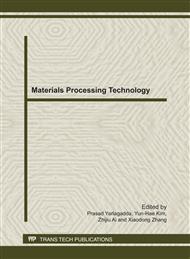[1]
T.C. Lee, L.C. Chan, B.J. Wu. Straining behavior in blanking process - fine blanking vs conventional blanking[J]. Journal of Materials Processing Technology, 1995, 48(1-4): 105-111.
DOI: 10.1016/0924-0136(94)01639-i
Google Scholar
[2]
L.C. Chan, Y.C. Leung, T.C. Lee, et, al. Numerical simulation for fine-blanking - a new approach[J]. Materials Science and Engineering A, 2004, 364(1-2): 207-215.
DOI: 10.1016/j.msea.2003.08.034
Google Scholar
[3]
R.-A. Schmidt, F. Birzer, B. Reh, et al. Cold Forming and Fineblanking: A Handbook on Cold Processing Steel Material Properties Part Design[M]. Carl Hanser Verlag Munchen Wien, Munchen, 2006.
Google Scholar
[4]
E. Taupin, J. Breitling, W.T. Wu, et al. Material fracture and burr formation in blanking results of FEM simulations and comparison with experiments[J]. Journal of Materials Processing Technology, 1996, 59(1-2): 68-78.
DOI: 10.1016/0924-0136(96)02288-1
Google Scholar
[5]
S.S. Kim, C.S. Han, Y.-S. Lee. Development of a new burr-free hydro-mechanical punching [J]. Journal of Materials Processing Technology, 2005, 162-163: 524-529.
DOI: 10.1016/j.jmatprotec.2005.02.110
Google Scholar
[6]
X.L. Xie, Z. Zhao, S. Yu, et al. 3D FEM modeling of Gear Wheel Fine-blanking Forming and the Process Optimization[J]. Journal of Shanghai Jiaotong University, 2006, 40(10): 1649-1653.
Google Scholar
[7]
X.C. Zhuang, Z. Zhao, X.L. Xie, et al. Numerical simulation and optimization of process parameters in fineblanking process[J]. Journal of Southeast University, 2006, 22(4): 514-518.
Google Scholar
[8]
F. Klocke, K. Sweeney, H.-W. Raedt. Improved tool design for fine blanking through the application of numerical modeling techniques[J]. Journal of Materials Processing Technology, 2001, 115(1): 70-75.
DOI: 10.1016/s0924-0136(01)00771-3
Google Scholar
[9]
T.S. Kwak, Y.J. Kim, M.K. Seo, et al. The effect of V-ring indenter on the sheared surface in the fine-blanking process of pawl[J]. Journal of Materials Processing Technology, 2003, 143-144: 656-661.
DOI: 10.1016/s0924-0136(03)00311-x
Google Scholar
[10]
S. Thipprakmas. Finite element analysis of V-ring indenter mechanism in fine-blanking process[J]. Materials & Design, 2009, 30(3): 526-531.
DOI: 10.1016/j.matdes.2008.05.072
Google Scholar


